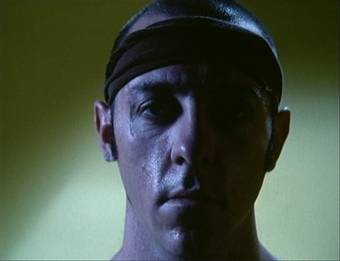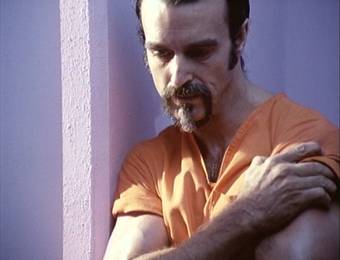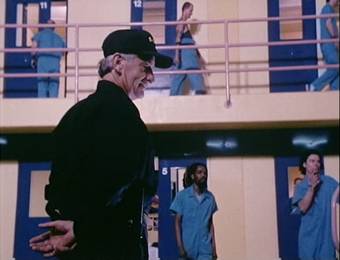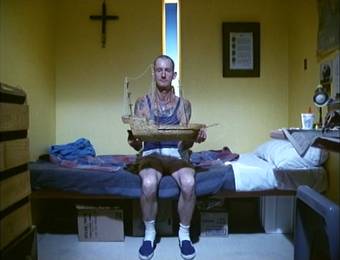"They
respect the man that wears the boot that's in their
face.
That's why they're here."
|
Guard – Central Industrial Prison
|
"They bred me to create fear, and I just did
what I was supposed to do."
|
Inmate – Central Industrial Prison
|
In
an age where the title of a film does not necessarily spell
out its content or even genre, Ghosts... of the Civil
Dead should still surely be up for some sort of
prize for opaqueness of meaning. Whether or not the title
rings any bells may depend on where you live – if you're
Australian you may well know it, but elsewhere the film
has had precious little exposure, despite the critical acclaim
that greeted it at its various festival screenings and on its limited
international release. Which is a shame, because it really
is something.
Ghosts...
is set in one of the so-called 'New Generation' jails that
were designed to be safer, more humane, give more control
to the staff, and reduce inmate tension and associated violence.
I didn't make that up, that's how they are described to
this day by correctional authorities (itself a term that
has grown out of the 'new generation' thinking) across America.
You can check this out for yourself at the web
site of the Sheriff of Alexandria in Virginia County,
which sells the Alexandria Detention Centre as a model of
New Generation Jail design and implementation in a
manner that makes it look and sound like a holiday village (well you could until the site was taken down).
At the very least it sounds progressive and potentially
effective. Except...

The
film begins with a textual prologue. Central Industrial
Prison, a maximum security facility designed specifically
to house society's most violent and unmanageable inmates,
has been in a state of 'lockdown' – where the prisoners
are confined to their cell block – for the past 37 months,
the longest in Australian prison history. What follows is
a record of the events that led to this situation.
There
is some intriguing misdirection in the first few minutes.
As a number of chained new inmates are marched into the
cell block in which the rest of the film will be set, we
are connected through voice-over to the thoughts of one of them, Henry Wenzil. Movie tradition, and especially prison
movie tradition, tells us a couple of things straight up – firstly, that he is to be our lead character, the one whose
journey we will follow from arrival to probable release,
and secondly, that he is the relative innocent of the
piece (something emphasised by his initial wide-eyed uncertainty),
the one whose experience and personality would most closely
match our own in this situation. But this soon proves not to be the case.
As Wenzil settles into his cell we move on to Jack Grezner,
who has been transferred after killing a guard at a previous place on incarceration and
sent to this institution, the voice-over informs us, "to undermine our
authority." Excuse me? It's at this point that it becomes
clear that the voice-over does not belong to Wenzil at all,
but an as-yet unidentified custodian. Perhaps it is part of the report
into the causes of the lockdown, something a computer
display that appears intermittently suggests is to form the thrust of the narrative. As the story progresses, other voices
make themselves heard, the most poignant of which belongs to a middle-aged man in solitary confinement, who looks
back on his imprisonment at the age of 16 and the pain of
never having slept with a woman. He thinks about it a lot,
but finds the thoughts obscured by dreams of violence, because
"It's all I know, it's all I've ever seen."
In
some ways, Wenzil does indeed meet narrative expectations,
learning the ropes from others and very quickly becoming a player within the inmate subsystem. But despite
his confidence, he's out of his depth and soon pays the
price through a form of jail justice that ultimately
reshapes him from a violent thief into something much
worse. Far from aiding his rehabilitation, the system helps
turn a man into a monster.
The
air is charged with tension and the threat of violence from
the opening frames, but as order on the block slowly
starts to disintegrate there is a growing and almost apocalyptic sense
of a society on the verge of complete, anarchic collapse.
The warders are increasingly on the defensive, and at a
key moment one of them quits on the spot, unable to face
another hour in a situation in which he fears for his life.
The arrival of a particularly psychotic inmate (played by
singer Nick Cave, one of the original writers) acts almost
as a focus for the pent-up anger and hostility of the others,
and the sense that the block is a human time bomb primed
to explode on a single wrong word is almost overwhelming.

Although
both clearly inspired by similar source material, it's hard
to believe that that makers of the HBO series Oz
had not seen Ghosts... when they embarked
on their own, justifiably praised project. The main set, the
cell block, is virtually identical (although this does reflect
the consistency of design in the New Generation prisons)
and the frank presentation of violence, sexual abuse, racism
and drug addiction, as well as the raw honesty of the language
that so marked Oz, are all present here
in recognisably similar form. Where the two do differ
is in their handling of the main characters – while as a TV drama series Oz relies on more traditional story arcs and
character engagement, Ghosts... maintains
a steely detachment and an almost documentary sense of observation
that makes for consistently unsettling and later downright disturbing
viewing. The sense of what it's like to go through such
a system feels very real and at times genuinely frightening, emphasised by
the canny casting of real ex-prisoners and guards and actors
who look and behave every inch the part.
Ghosts...
of the Civil Dead is more than just a prison movie, it's also an allegorical reflection of the changing nature
of law and order in a society that is encouraged to form
very specific responses to a perceived threat, one that is often
exaggerated and sometimes even manufactured – as producer
Evan English reminds us in the included interviews, "fear
is a great method of social control." But its prison
movie credentials are nonetheless crucial to its searing
effectiveness – the incidents detailed here have all taken
place in real New Generation prisons, one of which,
in Marion, Illinois, has been in a permanent state of lockdown
since the killing of two guards in 1983, an incident recreated in one of the film's most chillingly horrible
scenes. With that lockdown still in place and inmates confined
to their cells for up to 23 hours a day, not to mention
the human rights abuses taking place at Guantanamo Bay,
the film has lost none of its urgency or social relevance.
Here the prison system is seen less as a place of punishment
and correction than a machine for further criminalizing
its inmates. It remains an extraordinary work that demands
to be more widely seen outside of its native Australia.
With the latest collaboration between director John Hillcott
and writer Nick Cave, the dark western The Proposition,
released in the UK on 10 March, the timing is surely perfect
for Ghosts... to appear on UK DVD.
Framed
in its original aspect ratio
of 1.37:1, it has to be said that – particularly for a special edition –
the picture quality here is not all it should be. Sharpness and
colour are for the most part strong, and the contrast, though
a little fierce at times (which may be deliberate), is solid,
but there is quite a bit of dirt on the print, with dust
spots and even the occasional hair very visible. Grain is
also noticeable, but this is neither surprising nor particularly
distracting. In all other respects the transfer is very
good.
The
soundtrack is Dolby stereo 2.0 and is of very high quality,
with excellent separation and crystal clear reproduction
of music and sound effects. Even the main menu sounds good.
As
a Collector's Edition, you'd expect this disc to have a
decent set of extras, and it does not disappoint. Surprisingly,
there is no commentary track, but the plentiful interviews
provide so much information on the background and filming
that you are not left with the sense that you have been
short changed in any way. Indeed, actually cataloguing the
extra features here is an almost Herculean task, as many
of them are buried in subsections and found only by paying
close attention to each screen or experimenting with the
direction buttons on the remote control, and there is some
duplication in places. With this in mind, it seems only
appropriate that on the main menu we are invited to 'Explore
Extras'.

The
first section, Interviews, were
shot in 2002 and and include chats with director John Hillcoat
(25:26), co-writer and producer Evan English (17:52), co-writer,
actor and co-composer of the score Nick Cave (14:23) and
co-composer Blixa Bargeld (5:38). There is a lot of information
about the research and writing of the film here, the financing,
the use of real world former guards and prisoners in the cast, as
well as the influence of Jack Henry's book The Belly
of the Beast, the documentary Tattooed Tears,
the filming styles of Kubrick, Bresson and Ozu and even
Gillo Pontecorvo's The Battle of Algiers. It's all fascinating
stuff, and despite the high regard in which they all still hold
the film, there is no ego on display here. All are shot
on DV and sometimes directly to camera. The fourth wall
falls down completely with Bargeld, who refuses to redo
his opening intro to camera and then stops to take a phone
call.
This
is one of those cases when you have to look carefully, as
a small triangle on the lower right of screen indicates
that there is a second page, which can be highlighted by
pressing the right button on your remote. This will give
you a second page of Interviews with Evan English & John Hillcoat (14:39), Nick Cave
(9:34), co-composer Mick Harvey (5:14), and Blixa Bargeld
(7:54), all recorded in 1998 and which do cover some of
the same ground as the 2002 interviews, but actually provide
a wider level of detail on the research and background to
the film, and in some ways are even more interesting as
a result. Mention here is also made of 'The Aryan Brotherhood',
strengthening the connection with Oz. The
interviews are conducted by the filmmakers themselves on
analogue tape. The interview with Bargeld is more of a jokey
chat with friends, and none of them take it remotely seriously.
And
yes, there's a third screen of Interviews,
though these are audio only. Production designer Chris Kennedy
(12:30) describes the problems of constructing and maintaining
sets made largely from cardboard (due to the film's tiny
budget), and he has some nice anecdotal stories about the real-life
ex-prisoners used in the film and the chaos that exploded
at the wrap party. Actor Mike Bishop (8:20) talks by phone
about the real-life prisoner (again from Marion prison)
on which his character was based, and his experiences preparing
for and working on the film. Actor Vincent Gil (7:37) describes
his time on the film as one of the most disturbing experiences
he has ever had, but remains proud of the work. Brett Collins
(10:26) is an ex-prisoner who works with the Australian
Prisoners Action Group and campaigns for the welfare of
prisoners in general, and worked on the film as a consultant
and actor. He is also interviewed by phone and gives a fairly detailed history of his own
background and time in jail, then talks at some speed about his involvement
in the film. It should
be noted that you can't pause or fast wind any of these
interviews, so if you get interrupted mid way you'll have
to start again.
The next section, Nick Cave, has
a textual biography of the singer, but also included here
is a link to the 1988 and 2002 interviews detailed above,
and a Script Image (1:00), which
is a slow scroll down Cave's annotated script for the film.

Production
has 6 subsections, which themselves also have subsections
(you see what I mean?). In Concept & Research
there are 3 textual biographies, one each on The Belly of the Beast
author Jack Abbott, former Marion Penitentiary guard David
Hale, and justice campaigner Brett Collins. Each biography
includes links to other files. Under Jack Abbott's picture
you can find The Novel, a link
to stills of the cover of his book, and Letter
to Hillcoat (2:05), in which Hillcoat reads
(audio only, accompanied by a still of the document in question) the first
letter he received from Abbott, who was at that time incarcerated
in Marion. In David Hale's piece the Audio Tracks
contain 8 extracts (1-5 mins each) from the soundtrack CD,
4 of which include part of a phone conversation with Hale
about his experiences as a guard at Marion. His paints a
worrying picture of the management and administration there,
and talks about the murder of the two guards, which happened
while he was on duty. In Brett Collins' section there is
a link to his interview detailed above.
Filmmakers
contains biographies for John Hillcoat, Evan English, Nick
Cave, Chris Kennedy and director of photography Paul Goldman.
Links are provided to interviews and related materials found
elsewhere on the disc in the first four biographies; Goldman's
has none.
Cast
has biographies for David Field, Mike Bishop, Vince Gil,
Dave Mason and Nick Cave. These also provide links to related
interviews and features.
Storyboards
unsurprisingly features the storyboards, which are viewable a frame at a time for
two sequences in which killings take place (to reveal the
titles given would be a plot spoiler). You can also watch
each of the sequences without the boards from here.
Photographs
are just that, four pages of thumbnails of production photos
that can be enlarged to a reasonable size.
Music
& Sound has biographies of (once again)
Nick Cave, Mick Harvey and Blixa Bargeld, again with appropriate
links. There is also a link to the soundtrack extracts found
under the David Hale piece.
The
next section, Promotion, features
a Trailer (1:08), the French
Trailer (1:21), Print Promotion,
featuring poster artwork, stills taken at the Venice
and Cannes festivals, and a list of the film
Festivals at which Ghosts...
has played. Venice and Cannes
includes an audio extra, Arrest Story
(8:54), in which Hillcoat talks about the approach he and
Evan English took to promoting the film at the festivals,
creating simple but provocative posters and illegally sticking
them up at night wherever he found a space, which one night
resulted in him being arrested as a suspected terrorist.
The final section, Criticism,
has 3 subsections. Audio Essay
(9:10) is an audio review by freelance writer Ina Bertrand.
Review Quotes is exactly what
it says. Australian Prison Films
provides trailers for the 1980 Stir (2:56),
Ghosts... of the Civil Dead (1:24), the
1994 Everynight Everynight (2:22) and,
of course, the 2000 Chopper (1:42). The
Stir trailer looks very much like it has
been hauled off of second generation VHS.
Ghosts...
of the Civil Dead is a remarkable film that deserves to be far more widely seen than it
has been, at least outside of Australia. With the imminent
release of The Proposition, starring our
very own Ray Winstone, that may all be about to change,
who knows. For now this Australian Collector's Edition DVD
from Umbrella Entertainment and Street Smart Films is the only way to go. The print
could do with some cleaning up, but it's hard to fault the
extras, which provide a splendid level of background detail
to the production, and the film itself is a must-have. Highly
recommended.
|